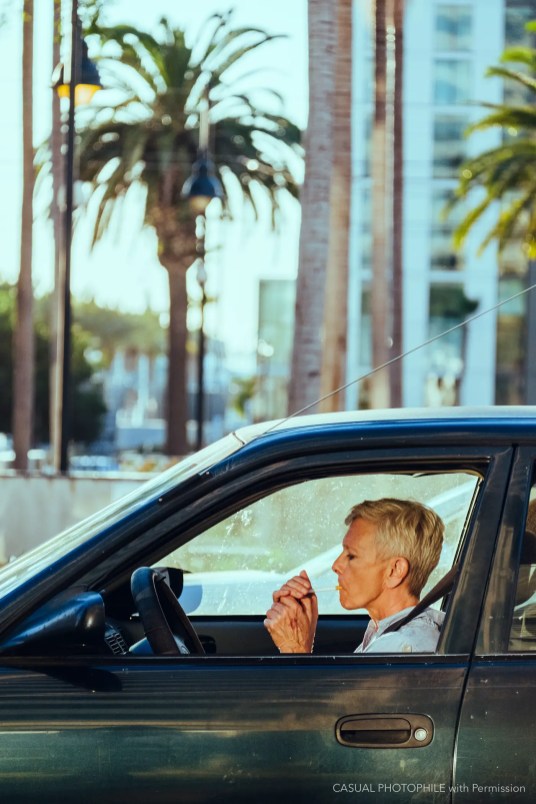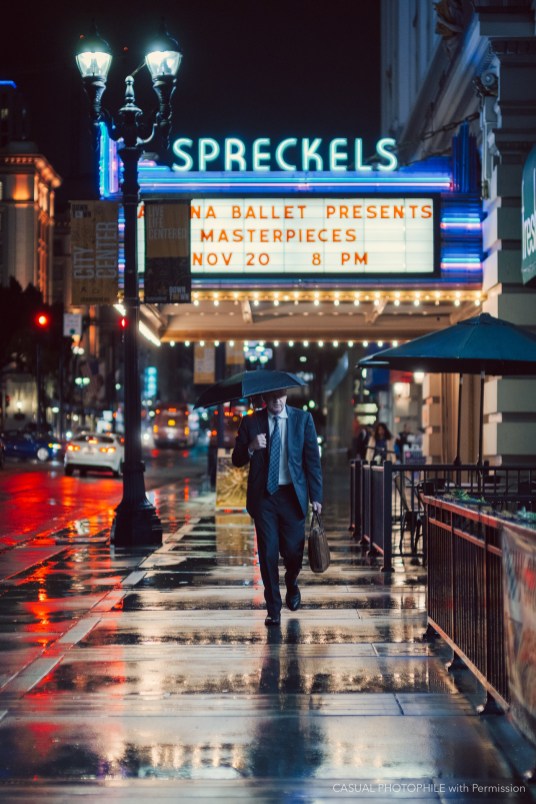Street Photography 101 tells us we need a 50mm lens and black-and-white film. This has been the formula for damn near eighty years. And it’s boring. The cure? Check out Ali’s work on today’s Featured Photophile. Using his unique vision and an ability to pre-visualize a scene, and with help from a telephoto lens and a fearlessness concerning color, Ali has created a body of street photography that’s both unusual and exceptional.
We asked him some questions. He answered. And we hope you enjoy it.


Thanks for joining us. Please introduce yourself to our readers.
My Name is Ali. I’m forty-three years old. I currently live in San Diego CA (since 2004). I was born and raised in Paris, France.
When did you start shooting? What’s your favorite camera, and why do you love it? What type of film do you use, and why?
I started shooting seriously in 2012. Before that, I used to take pictures that I would use as reference for my first artistic endeavor, hand drawn illustration and later on, digital painting.
As far as camera goes, I shot with many brands over the years and it’s difficult to choose a particular model as my favorite. All served their purpose at the time of their use. If I had to chose one that stood out, I’d say any Leica Ms (digital and film) more because it was such a unique shooting experience. I’ve shot with other rangefinders (Canonet QL17 GIII and Olympus XA) but Leicas are on another level as far as build quality goes.
Since I never got to use Kodachrome, I use Ektar 100. I love the vivid colors coming out of it. Like Kodachrome, it brings out and accentuates whatever colors are present in the scene.
What are your favorite subjects, and why?
I don’t really have any. I’ll shoot anything that captures my interest. It has to be aesthetically pleasing to my eye and it usually involves good lighting conditions, colors, shapes and gesture.


Why do you shoot film? Do you also shoot digital? What do you think are the greatest or most important differences between film photography and digital imaging?
When I first shot film it was because it was the only option since digital wasn’t yet invented. Later on, I chose film mostly because I like the look. All my favorite pictures were shot on film, mostly the sadly-defunct Kodachrome. For financial reasons, time constraint and because I like to be prolific (I shoot almost every day), I shoot mainly digital and shoot film for rare or intimate occasions like family and friends.
In the world of photography, the aim of the photographer is to capture the moment and whether or not he/she uses a film or digital camera shouldn’t matter that much.
Besides the obvious technical differences, both media work the same way when you consider the lighting conditions and background. But there are advantages in each that appeal to different photographers. Different doesn’t mean better or worse, it just means different, despite what some purists might say. You enjoy the process of shooting, developing, scanning film, or you prefer the instant feedback of digital. And there’s nothing wrong with either. In the end, we are all photographers; a bunch of weirdos pressing a button that’s connected to a box that stops time in the form of a picture.
What do you consider to be unique about your photography?
It’s unique in that I see mostly with telephoto eyes so my work reflect that vision. I love the compression and the ability to stack layers on top of each others. I also like my lines straight with zero distortion. More recently, many of my images are shot at 300mm, which is unconventional, especially when shooting on the streets. Using a telephoto lens also allows me to surgically extract elements out of the landscape and accentuate a sense of scale. When you combine all these elements, it gives your body of work a unique look. I’m aware that I’m in a minority.
How do you achieve your best results?
For me, it comes down to two things; improving your “eye” (or the way you see the world around you) and pre-visualization (knowing in advance how the image will look).



Do you have any advice for new photographers?
Yes. As much as you can, always take a camera with you and shoot, shoot, shoot. It’s cliché but there is no other way to master photography. Mastery only comes with practice. So, practice a lot.
On the days you can’t take pictures, look around you for photo opportunities. Look at the light, colors, shapes, etc. To quote Elliott Erwitt “Photography is an art of observation. It has little to do with the things you see and everything to do with the way you see them.”
Don’t get too caught up with camera equipment and all the technical stuff. The sooner you get the technical aspect of photography out of the way, the sooner you can focus on finding your own shooting style and look.
Beginners (and even intermediates) always ask “What type of camera and lens did you use?” and, “What software did you use to post process this shot?” It’s like asking great painters what type of brushes and canvas they use. Gear does matter but it can become a huge distraction that will end up wasting your time and money if you focus on it too much.
If your photos sucks, it’s because of you, not the gear. Upgrade yourself.
Where do you hope your photography goes from here?
I definitely want to publish photo books, each with a coherent body of work. Teaching a workshop is something that interest me as well. My approach would be more philosophical than technical.
Where can people see more of your images?
My two Instagram accounts here and here, my Flickr, and my Tumblr.

See all of our Featured Photophile articles here
Follow Casual Photophile on Facebook and Instagram
[Some of the links in this article will direct users to our affiliates at B&H Photo, Amazon, and eBay. By purchasing anything using these links, Casual Photophile may receive a small commission at no additional charge to you. This helps Casual Photophile produce the content we produce. Many thanks for your support.]











That train photo is everything. Great subframing and light. Boom!